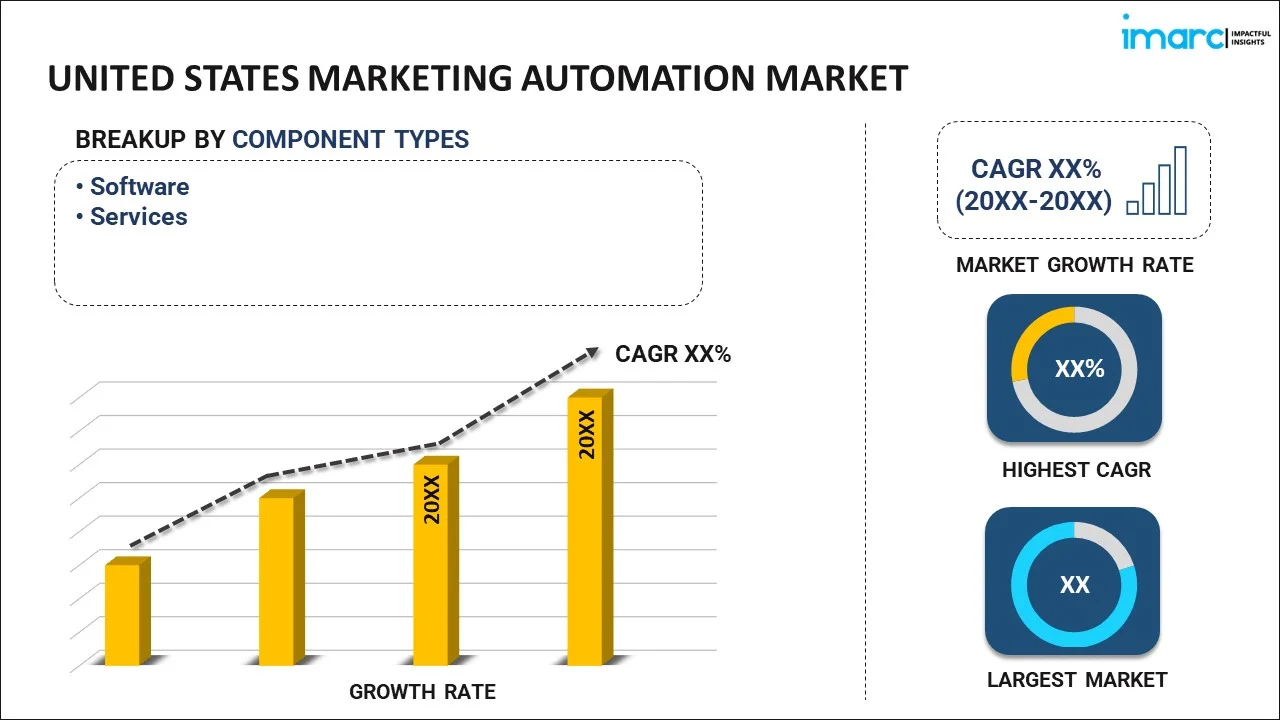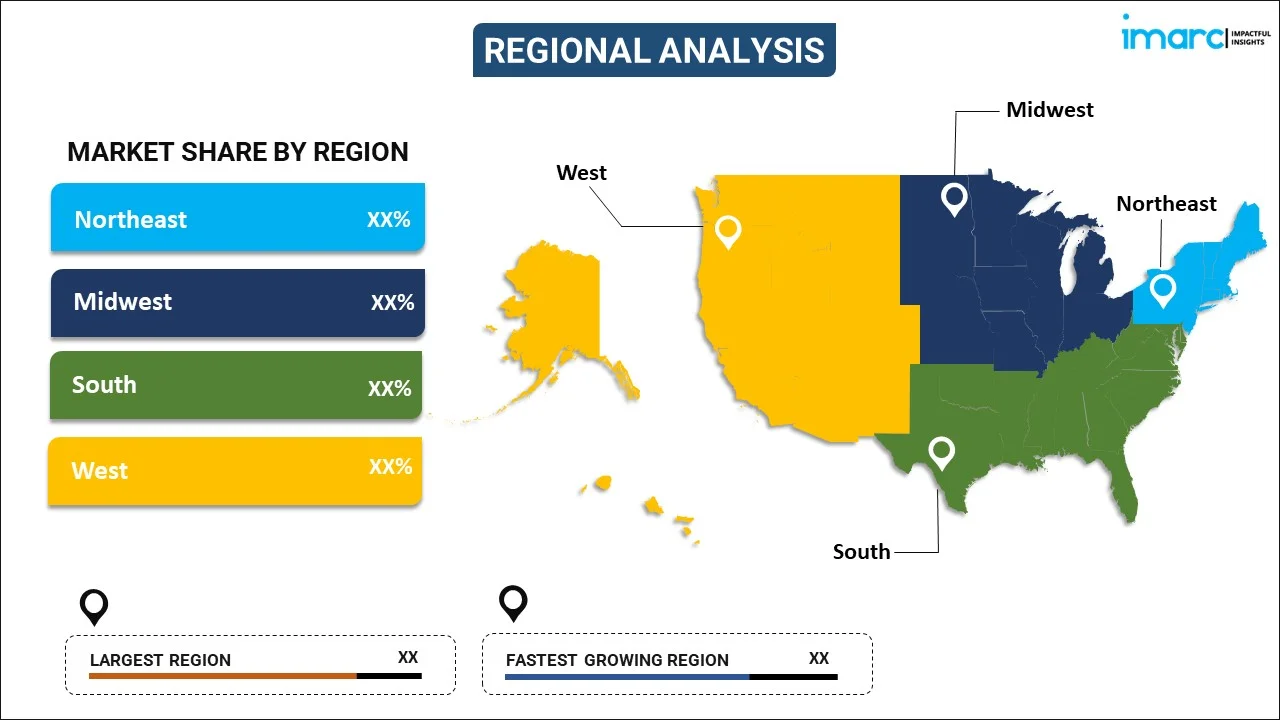
United States Marketing Automation Market Report by Component Type (Software, Services), Deployment Type (On-premises, Cloud-based), End User (SMEs, Large Enterprises), Application (Campaign Management, Email Marketing, Lead Nurturing and Lead Scoring, Social Media Marketing, Inbound Marketing, and Others), Vertical (BFSI, Retail, Healthcare, IT and Telecom, Government, Entertainment and Media, Education, and Others), and Region 2025-2033
Market Overview:
United States marketing automation market size reached USD 19.1 Billion in 2024. Looking forward, IMARC Group expects the market to reach USD 53.8 Billion by 2033, exhibiting a growth rate (CAGR) of 12.2% during 2025-2033. The rising focus of marketers on strategic initiatives, creative campaigns, and more robust customer relationship management is primarily driving the market growth across the country.
|
Report Attribute
|
Key Statistics
|
|---|---|
|
Base Year
|
2024 |
|
Forecast Years
|
2025-2033
|
|
Historical Years
|
2019-2024
|
| Market Size in 2024 | USD 19.1 Billion |
| Market Forecast in 2033 | USD 53.8 Billion |
| Market Growth Rate (2025-2033) | 12.2% |
Marketing automation involves the utilization of software platforms and tools to mechanize recurring marketing tasks and enhance the efficiency of marketing processes. This technology empowers businesses to automate various marketing activities, including email marketing, social media posting, lead nurturing, campaign management, and customer segmentation. The essence of marketing automation lies in its ability to facilitate personalized and targeted communication with customers, thereby enhancing engagement and increasing conversion rates. Its impact is reflected in time savings, reduced manual effort, and the optimization of marketing strategies through data-driven insights and analytics. Through the automation of routine tasks, marketers can redirect their focus towards strategic initiatives, creative campaigns, and more effective customer relationship management. Additionally, marketing automation plays a crucial role in lead generation and nurturing, providing businesses with the tools to monitor and manage leads across the entire customer journey.
United States Marketing Automation Market Trends:
The United States marketing automation market is a dynamic and evolving sector. Leveraging software platforms and tools, this market empowers businesses to automate repetitive marketing tasks, streamline processes, and enhance overall efficiency. Additionally, the demand for marketing automation solutions in the U.S. is fueled by the need for businesses to effectively manage and optimize their marketing activities. These platforms enable the automation of diverse tasks, including email marketing, social media posting, lead nurturing, campaign management, and customer segmentation. Besides this, the U.S. marketing automation market is characterized by its capacity to deliver personalized and targeted customer communication, thereby significantly improving engagement and conversion rates. Furthermore, beyond the efficiency gains, marketing automation in the U.S. allows businesses to harness data-driven insights and analytics to refine their marketing strategies. Businesses in the U.S. leverage these solutions to track and manage leads throughout the entire customer journey, making the marketing automation market a pivotal player in the country's tech-driven marketing landscape. This, in turn, is expected to fuel the regional market over the forecasted period.
United States Marketing Automation Market Segmentation:
IMARC Group provides an analysis of the key trends in each segment of the market, along with forecasts at the country levels for 2025-2033. Our report has categorized the market based on component type, deployment type, end user, application, and vertical.
Component Type Insights:

- Software
- Services
The report has provided a detailed breakup and analysis of the market based on the component type. This includes software and services.
Deployment Type Insights:
- On-premises
- Cloud-based
A detailed breakup and analysis of the market based on the deployment type have also been provided in the report. This includes on-premises and cloud-based.
End User Insights:
- SMEs
- Large Enterprises
The report has provided a detailed breakup and analysis of the market based on the end user. This includes SMEs and large enterprises.
Application Insights:
- Campaign Management
- Email Marketing
- Lead Nurturing and Lead Scoring
- Social Media Marketing
- Inbound Marketing
- Others
A detailed breakup and analysis of the market based on the application have also been provided in the report. This includes campaign management, email marketing, lead nurturing and lead scoring, social media marketing, inbound marketing, and others.
Vertical Insights:
- BFSI
- Retail
- Healthcare
- IT and Telecom
- Government
- Entertainment and Media
- Education
- Others
The report has provided a detailed breakup and analysis of the market based on the vertical. This includes BFSI, retail, healthcare, IT and telecom, government, entertainment and media, education, and others.
Regional Insights:

- Northeast
- Midwest
- South
- West
The report has also provided a comprehensive analysis of all the major regional markets, which include Northeast, Midwest, South, and West.
Competitive Landscape:
The market research report has also provided a comprehensive analysis of the competitive landscape. Competitive analysis such as market structure, key player positioning, top winning strategies, competitive dashboard, and company evaluation quadrant has been covered in the report. Also, detailed profiles of all major companies have been provided.
United States Marketing Automation Market Report Coverage:
| Report Features | Details |
|---|---|
| Base Year of the Analysis | 2024 |
| Historical Period | 2019-2024 |
| Forecast Period | 2025-2033 |
| Units | Billion USD |
| Scope of the Report | Exploration of Historical and Forecast Trends, Industry Catalysts and Challenges, Segment-Wise Historical and Predictive Market Assessment:
|
| Component Types Covered | Software, Services |
| Deployment Types Covered | On-premises, Cloud-based |
| End Users Covered | SMEs, Large Enterprises |
| Applications Covered | Campaign Management, Email Marketing, Lead Nurturing and Lead Scoring, Social Media Marketing, Inbound Marketing, Others |
| Verticals Covered | BFSI, Retail, Healthcare, IT and Telecom, Government, Entertainment and Media, Education, Others |
| Regions Covered | Northeast, Midwest, South, West |
| Customization Scope | 10% Free Customization |
| Post-Sale Analyst Support | 10-12 Weeks |
| Delivery Format | PDF and Excel through Email (We can also provide the editable version of the report in PPT/Word format on special request) |
Key Questions Answered in This Report:
- How has the United States marketing automation market performed so far and how will it perform in the coming years?
- What has been the impact of COVID-19 on the United States marketing automation market?
- What is the breakup of the United States marketing automation market on the basis of component type?
- What is the breakup of the United States marketing automation market on the basis of deployment type?
- What is the breakup of the United States marketing automation market on the basis of end user?
- What is the breakup of the United States marketing automation market on the basis of application?
- What is the breakup of the United States marketing automation market on the basis of vertical?
- What are the various stages in the value chain of the United States marketing automation market?
- What are the key driving factors and challenges in the United States marketing automation?
- What is the structure of the United States marketing automation market and who are the key players?
- What is the degree of competition in the United States marketing automation market?
Key Benefits for Stakeholders:
- IMARC’s industry report offers a comprehensive quantitative analysis of various market segments, historical and current market trends, market forecasts, and dynamics of the United States marketing automation market from 2019-2033.
- The research report provides the latest information on the market drivers, challenges, and opportunities in the United States marketing automation market.
- Porter's five forces analysis assist stakeholders in assessing the impact of new entrants, competitive rivalry, supplier power, buyer power, and the threat of substitution. It helps stakeholders to analyze the level of competition within the United States marketing automation industry and its attractiveness.
- Competitive landscape allows stakeholders to understand their competitive environment and provides an insight into the current positions of key players in the market.
Need more help?
- Speak to our experienced analysts for insights on the current market scenarios.
- Include additional segments and countries to customize the report as per your requirement.
- Gain an unparalleled competitive advantage in your domain by understanding how to utilize the report and positively impacting your operations and revenue.
- For further assistance, please connect with our analysts.
 Request Customization
Request Customization
 Speak to an Analyst
Speak to an Analyst
 Request Brochure
Request Brochure
 Inquire Before Buying
Inquire Before Buying




.webp)




.webp)












